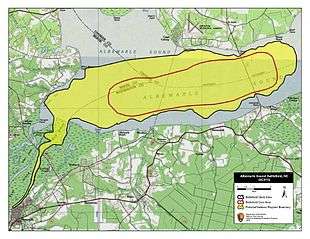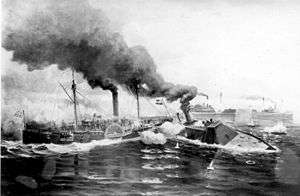Battle of Albemarle Sound
| ||||||||||||||||||||||||||||||||

The Battle of Albemarle Sound was an inconclusive naval battle fought in May 1864 along the coast of North Carolina during the American Civil War.[1] Three Confederate warships, including an ironclad, engaged eight Union gunboats. The action ended indecisively due to the sunset.[2]
Background
In April 1864, a Confederate Army, with the aid of the CSS Albemarle, forced the surrender of the Union garrison at Plymouth. Robert Hoke, commander of a Confederate Army in North Carolina, encouraged by his success at Plymouth attempted to retake New Bern which had been in Union control since early in 1862. For his proposed attack on New Bern Hoke again turned to the aid of Albemarle, which had been a decisive factor in the Battle of Plymouth.
Battle
James W. Cooke, commander of Albemarle sailed out of Plymouth in early May 1864. Steaming south toward New Bern, Cooke ran into a Union fleet at the mouth of Albemarle Sound, commanded by Captain Melancton Smith. Smith with an advantage in numbers could do little damage to the single Confederate ship. Shots glanced off Albemarle's sides. The USS Sassacus rammed Albemarle at top speed and caused some significant damage. Albemarle began taking on water but Sassacus had also sustained damage from the impact and a shot burst one of the boilers scalding the crew. The rest of the Union fleet managed to recapture a converted steamer called the CSS Bombshell.[3] Sassacus by now was too damaged to function and drifted down river while Albemarle was also damaged enough not to continue the fight and made its way back to Plymouth.
Aftermath
The battle itself was a standoff, but the events that followed had more decisive results. Albemarle had held its own against greater numbers but the damages caused the during the battle had forced the ship into port for the next several months, preventing it from being used in General Hoke's planned assault on New Bern. Hoke went ahead with his campaign even without Albemarle. He achieved nothing before being recalled to Virginia to help defend Petersburg and Richmond. The events in October had a greater impact on the situation when William B. Cushing led a naval raid and detonated a torpedo beneath the Albermarle's hull. The removal of Hoke's force and the destruction of Albemarle allowed both Plymouth and Washington, North Carolina, to fall back into Union hands
Order of battle
Union Navy
Captain Melancton Smith[4]
- USS Commodore Hull
- USS Ceres
- USS Miami
- USS Wyalusing
- USS Sassacus
- USS Mattabesett - flagship
- USS Whitehead
- Ida May (transport)
Confederate Mosquito Fleet
Commander James W. Cooke[4]
Notes
- ↑ "Battle Summary". National Park Service. Retrieved 5 May 2016.
- ↑ "Battle of Albemarle : Sound Civil War on the North Carolina Coast". Thomaslegion.net. Retrieved July 19, 2016.
- ↑ "Report of Actg Rear Admiral S P Lee". Ohio State University. Retrieved 5 May 2016.
- 1 2 "Edenton: Battle of Albemarle Sound". State Library of North Carolina. Retrieved 5 May 2016.
External links
- North Carolina Marker - Edenton - Battle of Albemarle Sound
- National Park Service battle description
Further reading
- Chaitin, Peter M., editor, The Coastal War: Chesapeake to the Rio Grande (1984)


.svg.png)